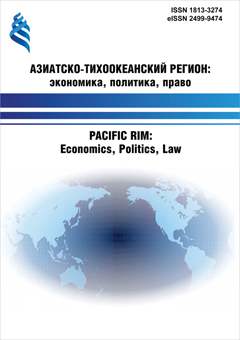ECOLOGY IN THE RFE REGIONS BORDERING WITH CHINA
Keywords:
ecology, pollution, sandstorms, China, Far East regions, environmental policy, the costs of environmental protectionAbstract
China's success in the economy causes severe pollution. Apart from China, these problems have had a negative impact on other states of the world. Increasing environmental problems is the price that China and its neighboring countries have to pay for the rapid economic development of PRC and its commitment to providing quality of life to the population at the level of world standards. With a rapid development of the economies in developing countries, environmental issues are being ignored due to their secondary importance in comparison with the production targets. China nowadays has to spend 4-8% of GDP on environmental protection (EP) in individual regions. However, it levels out the rate of economic growth and, therefore, at this stage, this task seems difficult to achieve. Given that the price of labor in China is growing, in conjunction with the costs of environmental protection, it will dramatically reduce the competitiveness of Chinese goods in the world market. Environmental problems caused by China, have a negative impact on the neighboring countries, primarily on Korea, Mongolia, Russia and Japan. Thus, violations of norms of loads on pastures have destroyed the upper layer of the soil, contributing to its transformation into dust and sand. Desertification leads to the formation of dust storms. Sandstorms in the form of rain and sand and mud often create problems for the regions of the Russian Far East. Since the beginning of the XXI century, dust storms have been frequently reaching Vladivostok. Environmental problems caused by China, influence health of both Chinese citizens and citizens of the neighboring countries. Disease rate growth in the population results in protests among China's population that have become more frequent since 2010. It should be noted that the Chinese authorities have reacted quite quickly to the ongoing unrest. Already in the 2010s, changes in domestic environmental policy of the state have become one of the priority tasks for the Government. A common drawback in the interaction of the NEA countries in the field of environmental protection is that it actually boils down mainly to the proclamation of declarations, joint plans without considering the mechanisms of their implementation, etc. There is no organization, whose tasks would reflect the collective interests of all countries in the region. The existing gaps make it impossible to ensure joint response to possible crisis situations, a perfect example of that being the benzene contamination of the Songhua River in 2005. The event received coverage only in the press of the countries that were contaminated, but no real joint actions were taken to neutralize the contamination. Moreover, Japan and the Republic of Korea, who offered their assistance to the affected areas, failed to render it due to the lack of bilateral agreements governing such actions. Analysis of the environmental situation in China and the neighboring countries clearly shows the lack of clear and comprehensive environmental policies in the PRC and its latent reluctance to spend more means on addressing the environmental problems. The problem is that China is focused on solving the people's social problems, which has become a national idea: the solution of this issue is closely related to the consolidation of society. With this approach, environmental problems are addressed last: they are only described and have a smoldering character.Downloads
Download data is not yet available.
Published
18-11-2022
Issue
Section
CHINA IN THE SPECTRUM OF COOPERATION IN THE REGION
How to Cite
Zharikov, E. P. (2022). ECOLOGY IN THE RFE REGIONS BORDERING WITH CHINA. PACIFIC RIM: Economics, Politics, Law, 1, 21-32. https://journals.dvfu.ru/ATR/article/view/361



